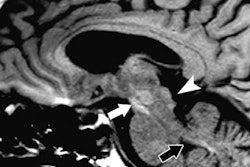
The use of perfusion MRI is growing for neurological applications, even though there is no specific reimbursement for the technique, according to a study published in the August issue of the American Journal of Roentgenology.
An international survey of more than 200 imaging providers found that tumors, strokes, and arterial stenoses are the most frequent reasons for using a variety of perfusion MR imaging techniques. However, the study authors also speculated that a "paucity of guidelines for specific clinical applications" could slow expanded utilization in the future.
"The important stumbling blocks for implementing perfusion MRI more broadly are the lack of standardization between different imaging techniques," said lead author Dr. Elliot Dickerson, a neuroradiology fellow at the University of California, San Francisco (UCSF). "But [the results] certainly reflect the fact that many people see the value in [perfusion MRI] for many clinical scenarios."
Absent guidelines
While many studies have evaluated the utility of perfusion MRI, Dickerson and co-author Dr. Ashok Srinivasan, an associate professor of radiology at the University of Michigan, found that few guidelines exist concerning the application of perfusion MRI in routine clinical practice. Two reasons they cited for this deficiency are the lack of large multicenter trials, which would help establish perfusion MRI's role in a particular clinical application, and the lack of reimbursement, which could discourage the modality's use.
 Dr. Elliot Dickerson from UCSF.
Dr. Elliot Dickerson from UCSF."When we started the study, we had this informal feeling that perfusion MRI was becoming a very common part of the clinical practice," Dickerson said. "Our goal was to better quantify the changes in practice patterns, even though [perfusion MRI] takes extra time that cannot be billed. A large part of that is because currently there is no reimbursement or formalized structure for performing perfusion MRI."
The researchers used an email list from the American Society of Neuroradiology to distribute a survey to 5,192 addresses from January 2015 to February 2015. The survey requested information about the institution, as well as whether perfusion MRI was offered, how decisions were made to perform the technique, and whether reimbursement was sought (AJR, August 2016, Vol. 207:2, pp. 406-410).
The two researchers received 243 responses (4.7%) from 195 institutions in 11 countries. Most returns came from the U.S. (175, 90%), followed by six or fewer replies from Canada, Spain, Brazil, Columbia, Australia, India, Italy, Japan, South Korea, and Saudi Arabia. Most also came from academic facilities (88 replies, 45%), followed by private practices (70, 36%) or a combination of the two (37, 19%).
Perfusion participation
Among the 195 institutions, 158 (81%) offered perfusion MRI for neuroimaging applications, the researchers found. Within that total, 83 (94%) of 88 academic institutions provided the service, followed by 43 (61%) of the 70 private practices and 32 (87%) of the 37 hybrid facilities. As expected, larger practices (95%) were more inclined to offer perfusion MRI than medium-sized practices (88%) and small practices (59%).
Most of the imaging facilities (66%) performed perfusion MRI at the request of the referring physician and if the radiologist thought it would benefit the patient (54%). Perfusion MRI was also the first choice among 80 imaging providers (52%) for all or nearly all neuroradiologic scans for intra-axial tumors.
Interestingly, only 32 (23%) of 141 radiology practices sought reimbursement for perfusion MRI. Facilities that did apply for payment billed the scans as an MR angiography procedure (24, 75%), while three institutions (9%) sought reimbursement for 3D reconstruction. One institution each described perfusion MRI as a form of MR spectroscopy or an advanced MRI technique in its reimbursement submission.
Clinical applications
Facilities used perfusion MRI most frequently for the following applications.
| MRI perfusion use by clinical application | ||
| No. of replies | Percent of total | |
| Evaluate brain tumors after treatment | 137 | 87% |
| Primary brain tumor assessment | 131 | 83% |
| Assessment of acute ischemic stroke | 68 | 43% |
| Evaluate cerebrovascular issues such as arterial stenosis | 56 | 35% |
| Evaluate acute stroke after treatment | 55 | 35% |
"It certainly reflects the fact that many people see the value in [perfusion MRI] for many clinical scenarios," Dickerson said. "The key applications are for characterizing tumors both before and after surgery. It can help detect recurrences early and differentiate tumor progression versus therapy response."
The most frequently used perfusion MRI method was dynamic susceptibility contrast enhancement (87%), followed by dynamic contrast-enhanced MRI (41%) and arterial spin labeling (35%). While these variations of perfusion MRI are helpful based on the targeted clinical application, a lack of standardization between the different techniques could hinder expanded use, Dickerson said.
"It may be difficult to know what a normal or abnormal value is," he said. "It takes some experience within an institution to build up its own catalog of normal values to understand how a particular method of doing perfusion MRI will produce the appropriate results."
Still, based on the survey results, the authors are quite optimistic about the future use of perfusion MRI.
"This widespread adoption of perfusion MRI beyond its apparent financial footprint suggests that practicing radiologists and their referring clinicians find value in this technique," they wrote. It also suggests the need for high-quality randomized, large, multicenter, patient outcome-oriented trials "to solidify our understanding of the role of perfusion MRI in various neuroradiologic applications."
"And, as we gain more experience with the technique, we will have better specificity and better diagnostic ability," Dickerson said.




















